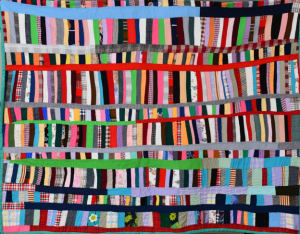Communities have been conceptualized as fabrics with libraries interwoven into the overall piece. Communities can also be perceived by community members as closed systems, wherein information restrictions exist for subgroups, prioritization directed towards “traditional” members and minimization of outside or “other” influences.” Weaving fabrics is deliberate and requires forethought to the strength of the individual threads, rate of decay of natural fibers and aesthetic. The analogy that may provide a more complex summarization is the patchwork quilt. A quilt is composed of three primary layers: top, insulating middle and the bottom or backing. Depending on the intent, perfect monotone patterns can be generated. Below, Mabel Williams improvised a quilt consisting of multiple fabrics, colors, and age of materials. On the top layer each piece is stitched to similar sized pieces and once the desired length has been achieved. Once the pattern of the top layer has been completed it is bonded to the middle and backing layers with a stitch that intersects all three layers. What once was a scrap piece before now is joined into a larger mosaic, multilayered and capable of providing comfort.

Mabel Williams, Improvisational Strip Quilt, 1968. cotton, polyester, wool, and twill hand quilted and hand pieced. Photo courtesy of the Mississippi Museum of Art. https://www.msmuseumart.org/wp-content/uploads/2023/02/35-scaled.jpg
Tangentially, the strength of a quilt is determined similarly to the strength of a reading culture. No one layer, no one thread carries the entire burden. Literacy capabilities have been in crises in California for decades and in my resident county, it is a well-known epidemic with seemingly no resolution. Lauersen (2025) libraries as our largest cultural institutions, that regardless of country identification have been decreasing in visitor attendance and therefore transmission of tangible and intangible cultural heritage. A significant portion of our reading from what I have gathered over the past few weeks has been focused on the larger, conducive picture of what can be achievable if we view our communities not as closed systems composed of minute, identifiable open systems but as complex systems. My greater community has an issue with literacy for both children and adults, with the awareness that most people within our community have not progressed past a third grade reading level. The National Center for Education Statistics estimate that 28% of Californians fall below the third-grade average and that statistically their children will have a 72% likelihood of not perpetuating a reading culture (Lucas, 2024).
A possible solution is utilizing bookmobiles. Libraries in other municipalities have adapted, continued, or returned to a tradition of a mobile library: bringing books to the people instead of people to the physical institution (Lauresen, 2025). In casual conversation with friends, acquaintances, and people in a variety of ques libraries at elementary schools are either limited in physical space, feature outdated material or are being run by support staff overseen by a principal or other administrator. Even recent EDJOIN postings are for individuals to perform librarian duties without the experience, knowledge, or adherence to the right to read principles. If the demarcation point of literacy is the third grade, we should be providing greater effort to this period of development via innovative methods. Public libraries can collaborate with public schools to expand their holdings and bring a degree of information literacy to the children. This is not in replacement of school libraries, but a stop gap measure to support literacy and another important cultural institution critical to society: the public school.
References
Lauersen, C. (2025, February 5). The necessary nearness – an ode to bookmobiles. Christian Lauersen. https://christianlauersen.net/2025/02/05/the-necessary-nearness-and-ode-to-bookmobiles/
Lucas, G. (2024). Report to the legislature on the California library literacy and English acquisition services program of the California State Library. https://www.library.ca.gov/uploads/2024/06/2024-CLLS-Report-to-Legislature.pdf

@gneissterran you make a compelling case for a fleet of bookmobiles to serve those in California that cannot get to the library to deliver books and other materials to those who may need them or want them. The quilt image is lovely!